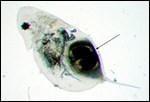|
An amazing number of aquatic plants and animals form resting stages, or have parts of their life cycles that are capable of leaving water to move to new locations. Resting stages or emerging stages can allow plants and animals that normally live in water to "migrate." The protection of a hard outer shell can allow aquatic organisms to be blown by the wind or carried by birds for great distances. Adults that emerge from water into air can go to other water bodies to lay eggs. But why would it be useful to be able to "migrate" from one body of water to another? Even the largest of water bodies is transitory in nature, given enough time. At times, rivers, streams, lakes, mud puddles, and even oceans can go dry. The current drought in Colorado reminds us of the transitory nature of even human-managed water bodies. Many aquatic plants and animals, especially the small ones, have developed coping mechanisms. Most nonvascular (lower) plants such as algae have one form or another of resting or spore stage, while vascular plants produce seeds- the ultimate in rugged, portable packaging of the next generation. 
Photo copyrighted and courtesy of Steve Potter and Terry Terrell.
While it may be difficult to picture wind as a major force in moving these small animals, scientists studying Rocky Mountain National Park believe we receive dust storms from as far away as China! Clearly wind can be an effective force in moving small objects over long distances.
Other aquatic animals live in water bodies only part of their lives, and emerge into the air or onto land as adults. The most well-known of these are the amphibians and insects. Stoneflies, mayflies, caddisflies, and dragonflies are only some of the better known insects with immature stages that live in water and adults that fly. Most of us have seen a dragonfly lightly tapping the surface of a pond with its back end. That insect was assuring a new generation of dragonflies by depositing her eggs into the pond. Most of us are also very familiar with the tadpole- frog cycle. Both insects and amphibians have developed an excellent strategy for dealing with catastrophes like drought- they "migrate." While no strategy will deal with every whim of nature, many aquatic organisms have developed ingenious means for dealing with the impermanence of their homes. |
Last updated: March 31, 2012
